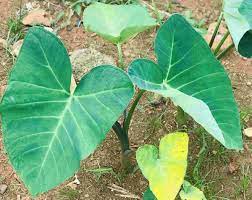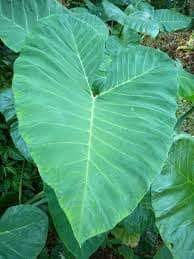Cocoyam leaves, also known as taro leaves or dasheen leaves, are the edible green leaves of the cocoyam plant (Colocasia esculenta). Cocoyam is a tropical plant widely cultivated for its starchy tuberous roots, but its leaves are also an important and nutritious part of the plant that is used in various culinary dishes in different parts of the world.
Cocoyam leaves are large, heart-shaped, and typically measure 20 to 40 centimeters (8 to 16 inches) in length. They have a distinct deep green color and a smooth texture on the surface. The leaves have a slightly glossy appearance and a tender yet robust texture. When cooked, they become softer but retain some firmness, making them suitable for various cooking methods.
Cocoyam leaves have a mild, slightly earthy flavor. They are often described as having a unique taste that is somewhat similar to spinach but with a subtle nutty undertone. Cocoyam leaves are highly nutritious and are rich in vitamins (such as A, C, and B vitamins), minerals (including iron, calcium, and magnesium), dietary fiber, and essential amino acids.
Cocoyam leaves are a staple in many cuisines, particularly in African, Asian, and Pacific Islander cuisines. They are commonly used in soups, stews, salads, and various other dishes. The leaves are often combined with other vegetables, meats, or seafood to create flavorful and nutritious meals.
Before cooking, cocoyam leaves are usually cleaned thoroughly, and any tough stems or veins are removed. They can be chopped, shredded, or used whole, depending on the recipe. Common cooking methods include boiling, sautéing, or adding them to soups and stews.
Cocoyam leaves are highly nutritious and provide essential vitamins and minerals that contribute to overall health. They are known to support digestive health, boost the immune system, and improve iron levels due to their iron content. Cocoyam leaves hold cultural and traditional importance in many regions where they are grown. They are often associated with traditional and festive dishes, symbolizing fertility, abundance, and community gatherings.
Cocoyam leaves are a versatile and nutritious leafy green vegetable widely used in cooking around the world, prized for their mild flavor and health benefits.
The Economic Importance and Uses of Cocoyam Leaves

Cocoyam leaves, also known as taro leaves or “soko” in some regions, have various economic importance and uses, especially in tropical and subtropical regions. These leaves are harvested from the cocoyam plant, which is a staple crop in many parts of the world.
Here are the economic importance and uses of cocoyam leaves:
1. Food Source: Cocoyam leaves are a significant source of nutrition and are commonly consumed as a vegetable in many traditional dishes. They are rich in essential nutrients such as vitamins A, B, and C, iron, calcium, and protein.
2. Dietary Diversity: Including cocoyam leaves in the diet contributes to dietary diversity, promoting a balanced and nutritious intake of various vitamins and minerals.
3. Income Generation: The cultivation and sale of cocoyam leaves can provide a source of income for farmers and individuals involved in the production and trade of these leaves. It’s a means of livelihood for many in rural and agricultural communities.
4. Local Markets: Cocoyam leaves are often sold in local markets and supermarkets, contributing to the economic activities in those areas. They are in demand due to their popularity and nutritional value.
5. Export Potential: In regions where cocoyam leaves are popular and have a significant market demand, they can be exported to generate foreign exchange earnings for the country.
6. Medicinal Uses: Cocoyam leaves are believed to have various medicinal properties and are used in traditional medicine to treat ailments like coughs, colds, and digestive issues. They are also considered to have anti-inflammatory properties.
7. Animal Feed: Cocoyam leaves are used as a supplementary feed for livestock, providing a source of nutrition for animals such as goats, cows, and pigs.
8. Soil Improvement: Cocoyam leaves can be used as green manure or incorporated into the soil after harvesting to improve soil fertility. This helps enhance crop growth and yields in subsequent farming seasons.
9. Sustainable Agriculture: The cultivation of cocoyam leaves can be integrated into sustainable farming practices, promoting crop diversification, reduced dependency on synthetic fertilizers, and enhanced crop resilience.
Read Also: 19 Medicinal Health Benefits Of Commiphora caudata (Guggul tree)
10. Traditional and Cultural Use: Cocoyam leaves have a cultural and traditional significance in many societies, being used in various traditional dishes and ceremonies. They often play a role in traditional festivals and gatherings.
11. Culinary Use: Cocoyam leaves are used in a variety of dishes, including soups, stews, stir-fries, and salads, adding flavor and nutrition to meals.
The Products and By-products That Can Be Derived From Cocoyam Leaves

Cocoyam leaves, also known as taro leaves or dasheen leaves, are an edible green leafy vegetable derived from the cocoyam plant (Colocasia esculenta). They are a staple in many cuisines, particularly in Africa, Asia, and the Pacific. Various products and by-products can be derived from cocoyam leaves, and I’ll explain each one:
1. Cooked Leaves (Main Product): The primary product from cocoyam leaves is their use as a cooked vegetable. The leaves are often boiled, sautéed, or used in stews and soups in various cuisines.
2. Stews and Soups: Cocoyam leaves are commonly used to prepare stews and soups in many African cuisines. Dishes like “Egusi soup” and “Oha soup” often incorporate cocoyam leaves for their flavor and nutrition.
3. Wrapped Foods: Cocoyam leaves can be used as natural wraps for foods like rice, beans, and other grains. The leaves impart a unique flavor to the wrapped food.
4. Leaf Sauce or Salsa: The leaves can be blended or ground to create a sauce or salsa, which is often used as a condiment or accompaniment for various dishes.
5. Cocoyam Leaf Porridge: The leaves can be used to make a nutritious and tasty porridge, often cooked with other ingredients like meat, fish, spices, and sometimes, groundnuts.
6. Fritters or Patties: Cocoyam leaves can be combined with other ingredients to make fritters or patties, which are then deep-fried to create a crispy snack or side dish.
7. Dried Leaves (By-Product): Cocoyam leaves can be dried and ground into a powder, which can be used as a flavoring or thickening agent in soups, stews, or sauces.
8. Animal Feed (By-Product): Dried or wilted cocoyam leaves can be used as supplementary animal feed for livestock like cattle, goats, and pigs.
9. Organic Fertilizer (By-Product): The remnants of cocoyam leaves after cooking can be composted and used as organic fertilizer for plants and crops.
10. Medicinal Extracts (By-Product): Some compounds extracted from cocoyam leaves are believed to have potential medicinal properties and may be used in traditional medicine.
11. Papermaking (Potential By-Product): In some cultures, cocoyam leaves have been explored for their potential in making paper, although this is not a widespread practice.
In conclusion, cocoyam leaves play a crucial role in both nutrition and economics, providing sustenance, income, and cultural significance in various regions where they are cultivated and consumed.
Read Also: Best Ways to Properly Dispose Scrap Computer Wastes

